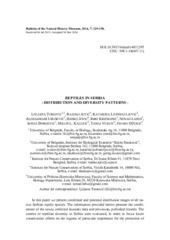Приказ основних података о документу
Gmizavci Srbije - rasprostranjenje i diverzitet
Reptiles in Serbia: Distribution and diversity patterns
| dc.creator | Tomović, Ljiljana | |
| dc.creator | Urošević, Aleksandar | |
| dc.creator | Ajtić, Rastko | |
| dc.creator | Ljubisavljević, Katarina | |
| dc.creator | Jović, Danko | |
| dc.creator | Krizmanić, Imre | |
| dc.creator | Labus, Nenad | |
| dc.creator | Đorđević, Sonja | |
| dc.creator | Kalezić, Miloš L. | |
| dc.creator | Vukov, Tanja | |
| dc.creator | Džukić, Georg V. | |
| dc.date.accessioned | 2015-08-28T10:26:51Z | |
| dc.date.available | 2015-08-28T10:26:51Z | |
| dc.date.issued | 2014 | sr |
| dc.date.issued | 2014 | |
| dc.identifier.issn | 1820-9521 | sr |
| dc.identifier.other | Rad_konverzija_552 | sr |
| dc.identifier.uri | https://radar.ibiss.bg.ac.rs/handle/123456789/514 | |
| dc.description.abstract | In this paper we present confirmed and potential distribution ranges of all native Serbian reptile species. The information provided herein presents the combination of the newly collected faunistic data and previously published records. The centres of reptilian diversity in Serbia were evaluated, in order to focus future conservation efforts on the regions of particular importance for the protection of this understudied group of animals. We found four main centres of species richness: three in Metohija and one in Šumadija, with 17-21 species per 50 × 50 km square. Analysis of the similarity of species composition in different regions of Serbia showed that South-eastern Serbia is the most distinct from other regions of Serbia, due to high number of Mediterranean species, with two being found exclusively in that region (E. quatuorlineata and P. najadum). Metohija is also very distinct, due to the highest number of species and significant number of specific (Mediterranean) faunal elements. The remaining geographic regions are grouped into three clusters, with Kosovo-Southern Serbia cluster being especially distinct in the terms of species richness and the presence of Mediterranean species. We also compared Serbian herpetofauna with those in other Balkan countries, considering species' numbers and zoogeographic herpetofaunistic elements. Serbian herpetofauna is closest to the Romanian. Zoogeographic analysis showed that reptilian fauna of Serbia consists of eight chorotypes, with the Eastern-Mediterranean (nine species) and Southern-European (five species) as the most dominant ones. | en |
| dc.description.abstract | U ovom radu predstavljeni su potvrđeni i potencijalni areali svih autohtonih gmizavaca Srbije. Korišćeni su do sada neobjavljeni podaci terenskih istraživanja, kao i informacije objavljene u literaturi. Ocenjeni su pretpostavljeni centri diverziteta gmizavaca u Srbiji, sa ciljem da se skrene pažnja na konzervacione mere neophodne za zaštitu pojedinih regiona od značaja za diverzitet gmizavaca u našoj zemlji. Utvrđeno je postojanje četiri centra diverziteta: tri u Metohiji i jednog u Šumadiji, sa prisustvom od 17 do 21 vrste na površini od 50 × 50 km. Analiza regiona Srbije po pitanju sličnosti sastava faune gmizavaca pokazala je da se region jugoistočne Srbije najviše odvaja od svih ostalih zbog ekskluzivnog prisustva dve mediteranske vrste gmizavaca (Elaphe quatuorlineata i Platyceps najadum). Metohija se odvaja po najvećem diverzitetu kao i prisustvu velikog broja mediteranskih vrsta gmizavaca. Ostali regioni formiraju tri grupe, pri čemu se klaster koga čine Kosovo i južna Srbija odvaja po prisustvu mediteranskih vrsta gmizavaca. Kada su na sličan način upoređene faune gmizavaca svih država Balkanskog poluostrva ispostavilo se da je fauna gmizavaca Srbije najsličnija onoj u Rumuniji. Zoogeografska analiza je pokazala da gmizavci Srbije spadaju u osam horotipova, pri čemu su po broju vrsta najzastupljeniji istočnomediteranski (sa devet vrsta) i južnoevropski (sa pet vrsta) horotipovi. | sr |
| dc.description.sponsorship | null | sr |
| dc.language.iso | null | sr |
| dc.rights | openAccess | sr |
| dc.source | Bulletin of the Natural History Museum | sr |
| dc.subject | reptile diversity | ENG |
| dc.subject | distribution | ENG |
| dc.subject | zoogeography | ENG |
| dc.title | Gmizavci Srbije - rasprostranjenje i diverzitet | sr |
| dc.title | Reptiles in Serbia: Distribution and diversity patterns | en |
| dc.type | article | sr |
| dc.rights.license | ARR | |
| dcterms.abstract | Вуков, Тања; Јовић, Данко; Урошевић, Aлександар; Лабус, Ненад; Ђорђевић, Соња; Калезић, Милош Л.; Љубисављевић, Катарина; Aјтић, Растко; Томовић, Љиљана; Джукић, Георг В.; Кризманић, Имре; Гмизавци Србије - распрострањење и диверзитет; Гмизавци Србије - распрострањење и диверзитет; | |
| dc.citation.issue | 7 | sr |
| dc.citation.volume | null | sr |
| dc.citation.spage | 129 | sr |
| dc.citation.epage | 158 | sr |
| dc.type.version | publishedVersion | sr |
| dc.identifier.fulltext | https://radar.ibiss.bg.ac.rs//bitstream/id/3172/Rad_konverzija_552.pdf | |
| dc.citation.rank | M52 | |
| dc.identifier.rcub | https://hdl.handle.net/21.15107/rcub_ibiss_514 |

